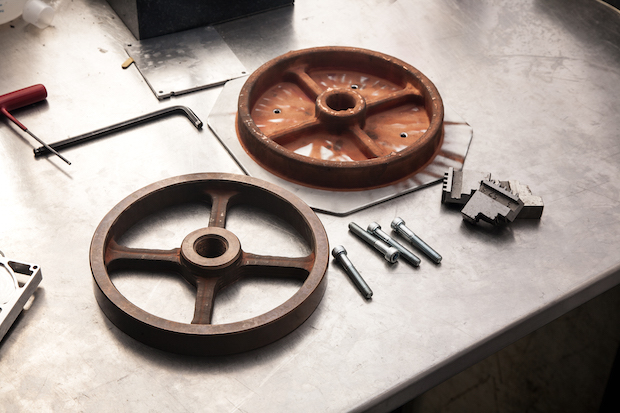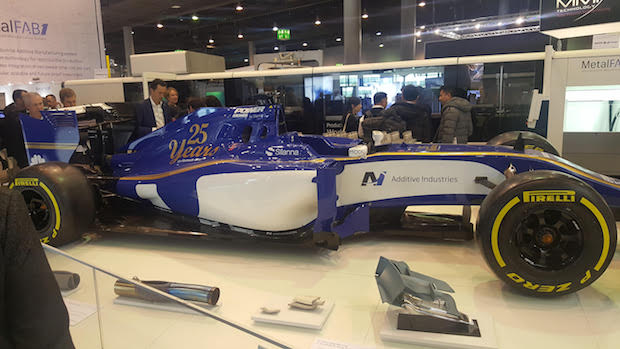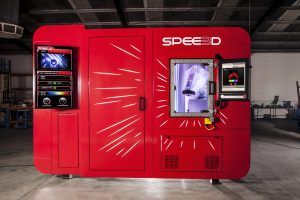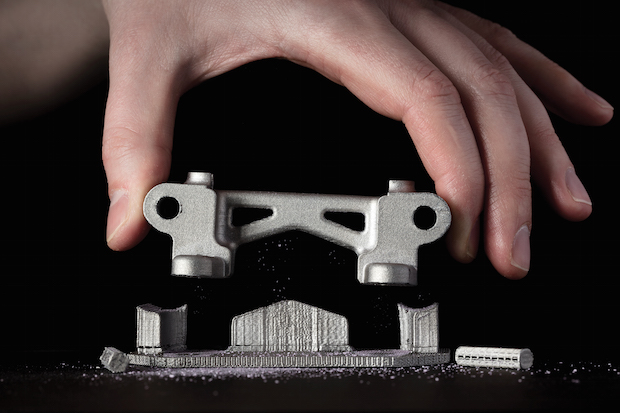Metal 3D Printing Takes Center Stage at formnext 2017

Two examples of a pulley printed with the Spee3D supersonic deposition metal 3D printer, one as pulled from the printer and the other after post-processing. Image courtesy of Spee3D.
Latest News
November 30, 2017
If the exhibits and announcements at formnext 2017 in Frankfurt this month are any indication, 2018 will be the year of metal for 3D printing.
There is nothing new about printing with metal per se, but this year saw several key announcements from 3D printer and software vendors. Right now metal is a high-end proposition, limited to the largest manufacturers with the highest requirements and the largest budgets. The news from formnext is a positive indication that metal printing is moving closer to wide-range adoption as currently enjoyed by the more mature polymer-based 3D printing technologies.
 No European engineering trade show is complete without at least one Formula 1 race car on the exhibition floor. Additive Industries used this Sauber Team F1 mockup to demonstrate the capabilities of its new MetalFab1 multi-material metal printing system.
No European engineering trade show is complete without at least one Formula 1 race car on the exhibition floor. Additive Industries used this Sauber Team F1 mockup to demonstrate the capabilities of its new MetalFab1 multi-material metal printing system.Spee3d Introduces Commodity Metal Printing
Creating aluminum die-cast parts for manufacturing is a $55 billion market globally, and it is expected to reach $80 billion by 2020. Much of the industry creates parts that don’t reach a consumer, but are used in manufacturing to create other products, or in industries such as mining or foundry work that need a wide range of cast parts to support their work processes. The Spee3D metal printer uses “supersonic 3D deposition” to print from commodity metal power in aluminum or copper. Image courtesy of Spee3D.
The Spee3D metal printer uses “supersonic 3D deposition” to print from commodity metal power in aluminum or copper. Image courtesy of Spee3D.Current metal 3D printers are high-end products designed to create special solutions for the aerospace, high tech and medical industries. They use custom-milled powders that are expensive to manufacture. A start-up 3D printing company from Melbourne, Australia thinks it has a solution that will allow cost-effective printing of the vast majority of die-cast parts.
Spee3D (“Speed”) introduces a new 3D printer that uses high-speed 3D deposition technology. Spee3D prints parts in minutes using a rocket nozzle to accelerate air up to three times the speed of sound. The printer literally smashes metal together with kinetic energy, delivering manufacturing grade high-density parts. The process does not melt powder during the formation process, allowing it to move more quickly through the production process than laser-based 3D printers.
Injected powders are deposited onto a substrate attached to a six-axis robotic arm. Spee3D calls the process “supersonic 3D deposition” because the kinetic energy from slamming the particles together causes the powders to bind together to form a high density part with normal metallurgical properties. Despite the supersonic speed of deposition, a Spee3D printer is not noticeably louder in operation than any other 3D printer.
“Spee3D was started after I experienced the slow pace and lack of rigor in the high cost, traditional metal 3D printing industry,” said Byron Kennedy, chief executive officer and co-founder of Spee3D. “In the past, users had to wait hours or even days to have a standard part delivered to them. Now, Spee3D can print these same parts in mere minutes, on-site and in real time.” The result, Kennedy says, is time-saving and cost-effective just-in-time production for single parts or runs of up to 10,000 parts.
Maximum part size is 300x300x300 mm. A part can weight up to 3000g. For now, the Spee3D printer will work with either copper or aluminum. The printer uses commodity metal powder; there is no need for expensive processed metals as in other metal 3D printers. “Commodity powders are low in cost and abundant,” notes Kennedy. The printer reads part data in the industry-standard STL format.
The product is manufactured in Melbourne, which noted 3D printing industry analyst Terry Wohlers calls “the hub of 3D printing in Australia.” The printer is now available directly from the company; distributors are being recruited. For more on Spee3D, check out our previous coverage.
 Two examples of a pulley printed with the Spee3D supersonic deposition metal 3D printer, one as pulled from the printer and the other after post-processing. Image courtesy of Spee3D.
Two examples of a pulley printed with the Spee3D supersonic deposition metal 3D printer, one as pulled from the printer and the other after post-processing. Image courtesy of Spee3D.Desktop Metal Seeks Mass Production Market
Another startup came to Frankfurt with a substantial war chest, a veteran team and an interesting mix of technologies. Desktop Metal introduced the Production System, which it says is the first metal 3D printing system for mass production of complex metal parts. The company claims it can produce complex metal parts up to 100 times faster than current laser systems, and intends to compete with traditional manufacturing processes. A smaller version for prototyping and small group use (Studio System) is already on the market; the larger Production System will ship before the end of 2017.The Production System uses Metal Injection Molding (MIM), a single-pass process similar to inkjet printing. Two key inventors behind Desktop Metal are Ely Sachs (binder jetting) and Paul Hoisington (single pass inkjet). The MIM process can use metal from the existing ecosystem of low-cost, high-quality alloys atomized in a variety of ways. The process does not require the uniformity of particle size as is required by laser-based 3D printing systems. DM says this makes materials for production up to 80% cheaper than traditional systems.
 The Desktop Metal Production system is designed for mass production of complex metal parts using a new single-pass process called Metal Injection Molding. Image courtesy of Desktop Metal.
The Desktop Metal Production system is designed for mass production of complex metal parts using a new single-pass process called Metal Injection Molding. Image courtesy of Desktop Metal.The Production System has a resolution of 1200 dpi, and a build area of 330x330x300 mm (apx. 13 in. in each dimension). It has a build rate of up to 8,200 cubic centimeters per hour.
While Spee3D seemed to come out of nowhere with its new printer, Desktop Metal has been building buzz as it worked its way toward launch this month. The company has raised $212 million in venture funding, with a D round of funding ($115 million) earlier this year which set a 3D printing industry record. Earlier this year Desktop Metal was named one of 30 “most promising technology pioneers” by World Economic Forum, and MIT Technology Review’s 2017 list of 50 smartest companies. The price has not been announced for the Production Series printer, but there is published speculation it will enter the market at around $440,000.
For more on Desktop Metal, check out our previous coverage.
Materialise Introduces Metal Printing Support Design
Materialise started as a 3D printing service bureau but quickly pivoted into a software developer as it sought to fill unmet needs customers would bring to its attention. For years, Materialise e-Stage for stereolithography and another version for digital light printing (DLP) has been used to automate the design of support structures needed for successful 3D printing. At formnext, Materialise introduced e-Stage for Metal, extending the capability to the new generation of metal printers.The company claims e-Stage for Metal will decrease support time by up to 90%, decrease support removal time by up to 50%, and decrease part finishing time by up to 20%. Materialise also says the use of e-Stage for Metal to design support structure will allow for nearly 100% recapture of metal powder trapped in the support structures.
“The time savings delivered by the automated generation of metal supports enables engineers to focus on other tasks. The elimination of manual work makes the process much more reliable and efficient, which allows us to meet increased customer demands,” says Ingo Uckelmann, Materialise Technical Manager of Metal 3D Printing in their Bremen, Germany plant.
Airbus was a beta tester of e-Stage for Metal. According to a press release, Airbus says it endorses “the e-Stage potential to reduce powder consumption, reduce post-processing time, increase build job speed while still guaranteeing a high quality build.”
For more on Materialise’s e-Stage for Metal, check out our previous coverage.
Subscribe to our FREE magazine, FREE email newsletters or both!
Latest News
About the Author
Randall S. Newton is principal analyst at Consilia Vektor, covering engineering technology. He has been part of the computer graphics industry in a variety of roles since 1985.
Follow DE





